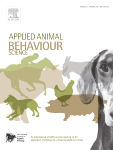Document type : Scientific article published in Applied Animal Behaviour Science
Authors: Lauréline Guinnefollau, Charlotte F. Bolwell, Erica K. Gee, Elizabeth J. Norman, Chris W. Rogers
Preview: Horses are used in many equine and veterinary science degree programmes during practical teaching classes for students to develop and refine their handling and clinical skills. There are few studies investigating the stress responses of these horses within the teaching environment. The aim of this study was to evaluate the physiological and behavioural responses of teaching horses during three types of practical teaching classes: equine handling (EH), medical rectal examination (MR) and mare reproductive rectal examination (RR). The study population included 20 teaching horses from three herds (mean time in herd of 7 ± 3 years). The horses' heart rate (HR) was assessed before (horses in holding yard and entering the stocks/teaching yard), during (horses in stocks/teaching yard, with or without interaction with students or lecturer) and after (horses in holding yard and leaving the stocks/teaching yard) a practical class. In addition, behaviour (pawing, eating hay, vocalisation, head surveying, tail swishing, repetitive head movement, shifting weight backwards and ears orientation) of the horses used during rectal examination classes was recorded. Median class duration was 99.50 min (IQR: 95.75-112.25 min) for EH, 37.50 min (IQR: 32.25-40 min) for MR, and 47 min (IQR: 47-48 min) for RR classes. Horses interacted with students for 26 % (RR) to 40 % (EH and MR) of the classes' duration. There was no change in median HR (35 bpm, interquartile range [IQR]: 33-39 bpm) between activities during EH classes. Median HR was greater when horses entered the stocks compared to the holding yard before the class in MR (entering stocks: 52.5 bpm, IQR: 43-58 bpm; yard-before: 39 bpm, IQR: 36-40 bpm; p = 0.047) and RR (entering stocks: 46 bpm, IQR = 41-49 bpm; yard-before: 37 bpm, IQR: 33-41 bpm; p = 0.031) classes. For both rectal examination classes, horses spent most of their time eating hay (MR: 94 %, IQR: 73-100 %; RR: 61 %, IQR: 46-79 %). In RR classes, horses spent less time eating hay (36 %) and had their ears pointed backwards more frequently (1.39 occurrences/min) during an interaction with a student compared to no interaction. Limited physiological and behavioural stress responses were observed in response to the three types of practical classes, suggesting this population of teaching horses may be habituated to both their use and environment for teaching.




